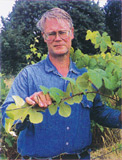 We’ve touched on the fact that the only sure way to grow grapes in Florida,
and any other tropical or subtropical type climate where North American
grape diseases have become established, is to plant grapes resistant to
them. Muscadine grapes, which evolved in the midst of those diseases,
were one type of grape mentioned. Muscadines aren’t the only grapes
to have evolved in such serious disease pressure, however. When the Spanish
first tried to colonize Florida they, as many Europeans did, brought grapes
with them. Those grapes were Vitis vinifera, the classic Old World
species which has no resistance to American grape diseases. In spite of that,
many of the vines lasted long enough to bloom and produce at least some fruit.
This is significant because grape botanists believe that those grapes spread
their pollen far enough to cross with native grape species and produce
plants that were a cross between the two species. One of the presumed signs
of this is the fact that wild grapes can be found in Florida with: much larger
clusters than is normal for wild species; fruit that is red or even white,
when pure species are most often blue; and flavors that are very mild, or
are entirely vinous.
We’ve touched on the fact that the only sure way to grow grapes in Florida,
and any other tropical or subtropical type climate where North American
grape diseases have become established, is to plant grapes resistant to
them. Muscadine grapes, which evolved in the midst of those diseases,
were one type of grape mentioned. Muscadines aren’t the only grapes
to have evolved in such serious disease pressure, however. When the Spanish
first tried to colonize Florida they, as many Europeans did, brought grapes
with them. Those grapes were Vitis vinifera, the classic Old World
species which has no resistance to American grape diseases. In spite of that,
many of the vines lasted long enough to bloom and produce at least some fruit.
This is significant because grape botanists believe that those grapes spread
their pollen far enough to cross with native grape species and produce
plants that were a cross between the two species. One of the presumed signs
of this is the fact that wild grapes can be found in Florida with: much larger
clusters than is normal for wild species; fruit that is red or even white,
when pure species are most often blue; and flavors that are very mild, or
are entirely vinous. We can only guess at the full story, but it’s possible that Native Americans found some of the early hybrids and carried fruit elsewhere, spreading the seeds. Plants which inherited the best disease resistance from their wild ancestors would have the best chance of survival, while the Native Americans, and possibly some of the settlers, would choose the best quality fruit. After a few generations of this sort of unintentional plant breeding, there were ‘wild’ grapes which easily survived in the Florida climate and in the presence of serious disease, but had fruit quality more like V. vinifera than anything that existed before the Spanish landed. Vitis shuttleworthii is the species most commonly associated with these superior ‘wild’ grapes. Vitis shuttleworthii is considered by some botanists to be a subspecies of Vitis aestivalis, a very widespread species that extends into Texas and at least half way to Canada. As a whole, the species has excellent resistance to disease, including resistance to Pierce’s Disease. As a result, there are grape varieties bred in other areas using V. aestivalis that often have sufficient resistance to P.D. to survive in Florida, though they may need to have some control of the fungal diseases. Most of these are varieties bred by T. V. Munson of Denison, Texas, and include names like Carman, America, and a great many others. Many of Munson’s grapes have been used in the breeding of newer grapes with high resistance to P.D. in other states. Miss Blue and Miss Blanc, from (or course) Mississippi are two of them.
Munson’s book, Foundations of American Grape Culture is still a classic and an excellent reference. It can be read online by going to: http://chla.library.cornell.edu/ and search for Foundations of American Grape Culture. Early in the 20th Century, plant explorers began to find some of the good fruited V. shuttleworthii types and make use of them. The work of Joseph Fennell was important in finding and utilizing these superior wild types in breeding. The Fennell selections were used in breeding varieties such as Lake Emerald, which is a productive green grape that needs little or no spray in many parts of Florida and is resistant to Pierce’s Disease. His material is still in use, and in the ancestry of many grapes bred by Florida A & M. A recent annual report of the University can be downloaded in PDF format at: http://www.famu.edu/acad/colleges/cesta/viticulture-annual-report.pdf
We'll continue with more grapes next column: